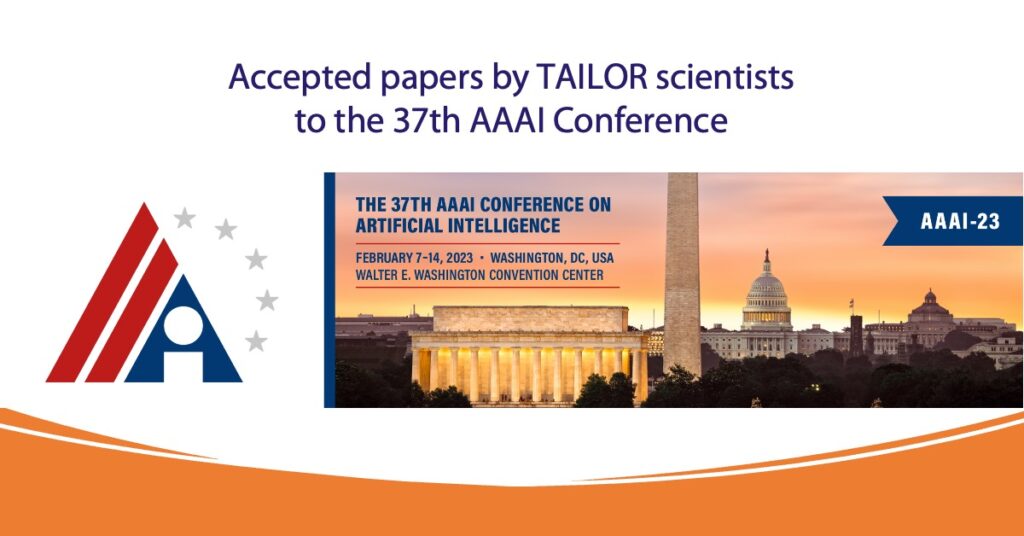A lot of TAILOR scientists submitted their paperwork to the 37th AAAI Conference on Artificial Intelligence (AAAI 2023), which will take place in n Washington, DC, US from February 7th to 14th, 2023.
Here below is the (not full) list of accepted papers presented by people involved in TAILOR:
- Giulio Rossolini, Federico Nesti, Fabio Brau, Alessandro Biondi, and Giorgio Buttazzo, “Defending From Physically-Realizable Adversarial Attacks Through Internal Over-Activation Analysis“.
- Fabio Brau, Giulio Rossolini, Alessandro Biondi, and Giorgio Buttazzo, “Robust-by-Design Classification via Unitary-Gradient Neural Networks“.
- Benjamin Aminof, Giuseppe De Giacomo, Sasha Rubin, “Reactive Synthesis of Dominant Strategies”.
- Alessandro Ronca, Nadezda Alexandrovna Knorozova, Giuseppe De Giacomo, “Sample Complexity of Automata Cascades”.
- Roberto Cipollone, Giuseppe De Giacomo, Marco Favorito, Luca Iocchi, Fabio Patrizi, “Exploiting Multiple Abstractions in Episodic RL via Reward Shaping“.
- Thibault Gauthier, Josef Urban, “Learning Program Synthesis for Integer Sequences from Scratch“
- Anna Gautier, Nick Hawes, Bruno Lacerda, and Michael Wooldridge. Multi-Unit Auctions for Allocating Chance-Constrained Resources
- Gianvincenzo Alfano, Sergio Greco, Francesco Parisi, Irina Trubitsyna, “Abstract Argumentation Frameworks with Conditional Preferences”
- Dimosthenis C. Tsouros, Tias Guns and Kostas Stergiou, “Learning constraint models from data“
- Maxime Mulamba Ke Tchomba, Emilio Gamba and Tias Guns, “Constraint solving for Prediction + Optimisation problems“
- (demonstration) Tias Guns, Emilio Gamba, Maxime Mulamba Ke Tchomba, Ignace Bleukx, Senne Berden and Milan Pesa, “Sudoku Assistant – An AI-powered app to help solve pen-and-paper Sudokus“
- Songtuan Lin, Gregor Behnke, Simona Ondrčková, Roman Barták, Pascal Bercher, “On Total-Order HTN Plan Verification with Method Preconditions — An Extension of the CYK Parsing Algorithm“
- Leonardo Lamanna, Luciano Serafini, Mohamadreza Faridghasemnia, Alessandro Saffiotti, Alessandro Saetti, Alfonso Gerevini, Paolo Traverso, “Planning for Learning Object Properties“
- Sarit Kraus, Yaniv Oshrat, Yonatan Aumann, Tal Hollander, Oleg Maksimov, Anita Ostroumov and Natali Shechtman, “Customer Service Combining Human Operators and Virtual Agents: a Call for Multidisciplinary AI Research“.
- Yohai Trabelsi, Abhijin Adiga, Sarit Kraus, S.S. Ravi, Daniel J. Rosenkrantz, “Resource Sharing Through Multi-Round Matchings“
- Sarit Kraus B11: AI and Law https://aaai.org/Conferences/AAAI-23/bridge-program-cfps/#bp11
- Michael Bernreiter, Wolfgang Dvorak, Anna Rapberger, Stefan Woltran, “The Effect of Preferences in Abstract Argumentation Under a Claim-Centric View“
- Markus Brill, Stefan Forster, Martin Lackner, Jan Maly and Jannik Peters, “Proportionality in Approval-Based Participatory Budgeting“
- Johannes Fichte, Markus Hecher, Stefan Szeider, “Inconsistent Cores for ASP: The Perks and Perils of Non-Monotonicity“
- Markus Hecher: Characterizing Structural Hardness of Logic Programs: “What makes Cycles and Reachability Hard for Treewidth?“
- Lucas Kletzander and Nysret Musliu, “Large-State Reinforcement Learning for Hyper-Heuristics“
- Martin Lackner and Jan Maly, “Proportional Decisions in Perpetual Voting“
- Franz-Xaver Reichl, Friedrich Slivovsky, Stefan Szeider, “Circuit Minimization with QBF-Based Exact Synthesis“
- G. Cima, M. Console, M. Lenzerini, A. Poggi, “Epistemic Disjunctive Datalog for Querying Knowledge Bases“
- Hasra Dodampegama and Mohan Sridharan, “Back to the Future: Toward a Hybrid Architecture for Ad Hoc Teamwork“
- Mohan Sridharan, “Integrated Knowledge-based and Data-driven Reasoning, Learning, and Collaboration in Robotics“. (Bridge Session on AI and Robotics)
- Raphael Fischer, Matthias Jakobs, Katharina Morik, “Energy Efficiency Considerations for Popular AI Benchmarks“
- König, Bosman, Hoos, van Rijn, “Critically Assessing the State of the Art in CPU-based Local Robustness Verification“
- M. Fuccellaro, L. Simon, A. Zemmari, “A Robust Drift Detection Algorithm with High Accuracy and Low False Positives Rate“
